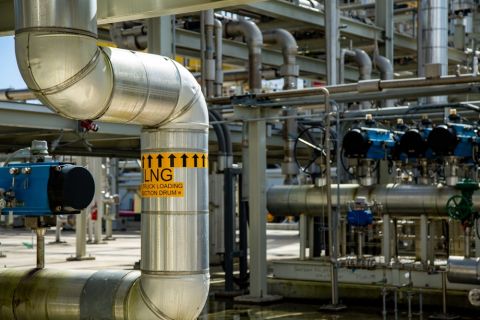
Joshua Lawson, Gulfport’s vice president of operations, talks about the advancements made in D&C that exceeded the company's production target in Q3 at Hart Energy's DUG Midcontinent Conference and Exhibition. (Source: Mary Holcomb, Hart Energy)
OKLAHOMA CITY—Three years ago, Gulfport Energy Corp. took a $1.85 billion gamble to enter Oklahoma’s Scoop. In third-quarter 2019, the company exceeded target production averaging 281.5 million cubic feet of gas equivalent per day (cfe/d) to round off a successful year in the play.
Back in 2018, the Oklahoma-based natural gas-focused E&P shifted focus to full section development in the Scoop after an underwhelming 2017. Today, Gulfport’s decision has enabled its Scoop position to contend with its Utica assets, where it holds over 210,000 net acres in Ohio and is the play’s second largest gas producer.
Though a smaller position with roughly 92,000 net reservoir acres, the Scoop has shown more potential for liquids than its larger counterpart, according to Gulfport’s Vice President of Operations Joshua Lawson.
“[The Scoop] is definitely an important part of our portfolio and what we’re really excited about from the onset, as far as the Scoop’s concerned, was the exposure to liquid,” Lawson said at Hart Energy’s recent DUG Midcontinent Conference and Exhibition.
D&C Initiatives
Lawson said in the full development plan, Gulfport utilized information from an appraisal well and applied it to the remaining wells in the unit. The company extended that strategy into 2019 with its eight-well development program in the Woodford Shale.
“We gained a lot of information from that project and we feel very comfortable with the efficiency gains that we’ve made on the drilling and completions side that we’re going to be able to take that information, deploy that into our program for 2020 and actually be able to deliver more with less,” Lawson said.
“In the drill-out phase of the operation we’ve seen a 31% reduction in our cycle time. A well that would take us 8.5 days to drill out, get the wellbore cleaned out and get it ready for production is now getting knocked out in about 5 days.”
Over three years, Gulfport has reduced drilling times in its Woodford wet gas wells from 72 days to a current average of 54 days while still increasing lateral footage. Lawson said this advancement is the result of Gulfport utilizing its seismic data to understand formation bed dips and paying “critical attention” toward pad placement.
About “85% of our lateral footage in 2017 was landed in-zone in the target area that we were shooting for,” he said, adding, “In 2019, 99.2% of our lateral footage was drilled exactly where we wanted it to be so that was absolutely critical to the advancements that we made.”
“To be able to operate in this environment, especially in a basin like the Scoop, the cycle times are absolutely critical,” he said.
Getting With The Program
This year, Gulfport kicked off its eight-well development project. Lawson said the objective was to test increased sand loading, increased stage spacing and the utilization of 100 mesh, “we were very intentional in the way that we set this project up.”
“Our base frac design was 210-foot stage spacing, 2,100 pounds per foot (lbs/ft), 15% 100 mesh on the front end and 85% 40/70 on the back end,” he explained.
“We didn’t want our results to be influenced by an unbounded well. So, as we took the four wells on the outside of the unit—wells 1 and 2 on the west of the unit, and wells 7 and 8 on the east side—we made those our control wells,” Lawson added. “We ran our base design on those control wells and really focused in on those interior, bounded wells. Those were the wells that we decided to turn the knob, so to speak.”
With the interior wells, Gulfport took a more aggressive approach by increasing sand loading, stage spacing and the use of 100 mesh in all of the wells. But, on wells 3 and 4 Gulfport held the design constant and just increased the proppant loading to about 3,000 lbs/ft with 210-ft stage spacing. With wells 5 and 6, however, Gulfport increased stage spacing to 315 ft and roughly 2,000 lbs/ft, and the company also ran diverters in well 5.
The wells, with the exception of well 2 in the lower area, landed in the Upper Woodford.
“We really wanted to try and determine on a full section development project or when you’re coming in to infill a unit, what is the point of diminishing returns,” he said in regards to increasing the proppant loading on wells 3 and 4. He noted that these wells performed the best and produced the most to date.
“We all know from pumping more proppant and increasing these job sizes, operators have started to see better well performance. But, when you’re coming in to infill a unit or coming in for full section development, where is that break-over? Would we still continue to see improved performance by increasing that proppant loading,” he added.
“We definitely did see an improvement in production by ramping up our proppant loading and going to that 3,000 lbs/ft. That was pretty significant considering the fact that they were interior wells and they were actually outperforming the unbounded wells just by ramping up our proppant intensity,” Lawson said.
Gulfport is looking into finding the point of diminishing returns, especially with the eight-well program.
“It is a balance between how much capital you actually want to put into the ground and the amount of incremental gain you’re getting from that,” he said. “We’ve had discussions as to whether we need to push the boundaries further or if we’re happy with the current results that we have.”
On increasing stage spacing, Lawson said the company didn’t want to take too big of a step out because limited entry and cluster efficiency was a concern.
“If you’re trying to achieve 2,100 pounds per foot, you go to a 500-foot stage. In the Scoop, we’re treating at 12,000 psi many times so it’s very high pressure and taxing on the equipment,” he said, “and the ability to pump a 6-hour job successfully and remain efficient is difficult to do. Plus, as you continue to increase your stage spacing, the cost savings begin to flatten out.”
Lawson warned operators that wanted to save capital by increasing stage spacing to take a hard look at their limited entry design and consider running some diverters, but he also made clear that “there’s no one size that fits all.”
The bigger decision of pumping 100 mesh, Lawson said, was due to proppant carrying capabilities and also seeing a 22% reduction in cost savings by using local sand mines and regional proppant.
Collectively, the program boosted Gulfport’s production in the Scoop by 9% and reduced stage costs by 15% to 25%.
“Everybody knows that the times we’re currently living in, being able to produce and gain the same well results with deploying less capital, is kind of the name of the game,” he said. “Trying to find every little penny that we can—pick it up off the ground and stick it in our pockets—is what everybody is shooting for.”
Moving into 2020, Gulfport targets 230-ft stage spacing at a minimum of 2,400 lbs/ft and longer laterals that reach 10,000 ft. Gulfport will also continue to run 100 mesh, Lawson said.
“The Scoop will continue to be a meaningful piece of our portfolio moving forward,” he said.
Recommended Reading
BP Restructures, Reduces Executive Team to 10
2024-04-18 - BP said the organizational changes will reduce duplication and reporting line complexity.
Kimmeridge Fast Forwards on SilverBow with Takeover Bid
2024-03-13 - Investment firm Kimmeridge Energy Management, which first asked for additional SilverBow Resources board seats, has followed up with a buyout offer. A deal would make a nearly 1 Bcfe/d Eagle Ford pureplay.
President: Financial Debt for Mexico's Pemex Totaled $106.8B End of 2023
2024-02-21 - President Andres Manuel Lopez Obrador revealed the debt data in a chart from a presentation on Pemex at a government press conference.
New Fortress Energy Sells Two Power Plants to Puerto Rico
2024-03-18 - New Fortress Energy sold two power plants to the Puerto Rico Electric Power Authority to provide cleaner and lower cost energy to the island.
Talos Energy Expands Leadership Team After $1.29B QuarterNorth Deal
2024-04-25 - Talos Energy President and CEO Tim Duncan said the company has expanded its leadership team as the company integrates its QuarterNorth Energy acquisition.




